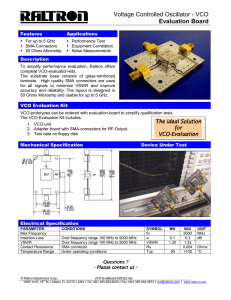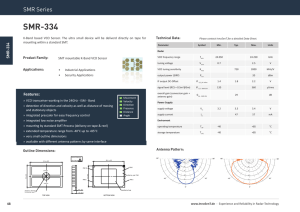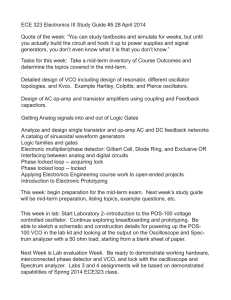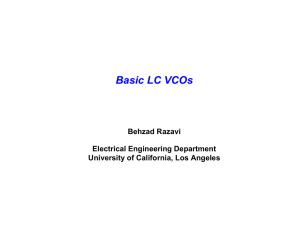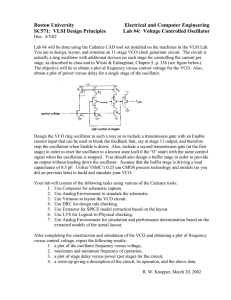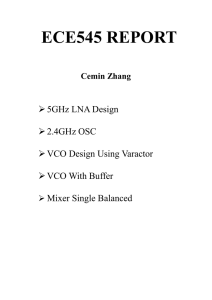A 23 GHz low power VCO in SiGe BiCMOS technology
advertisement
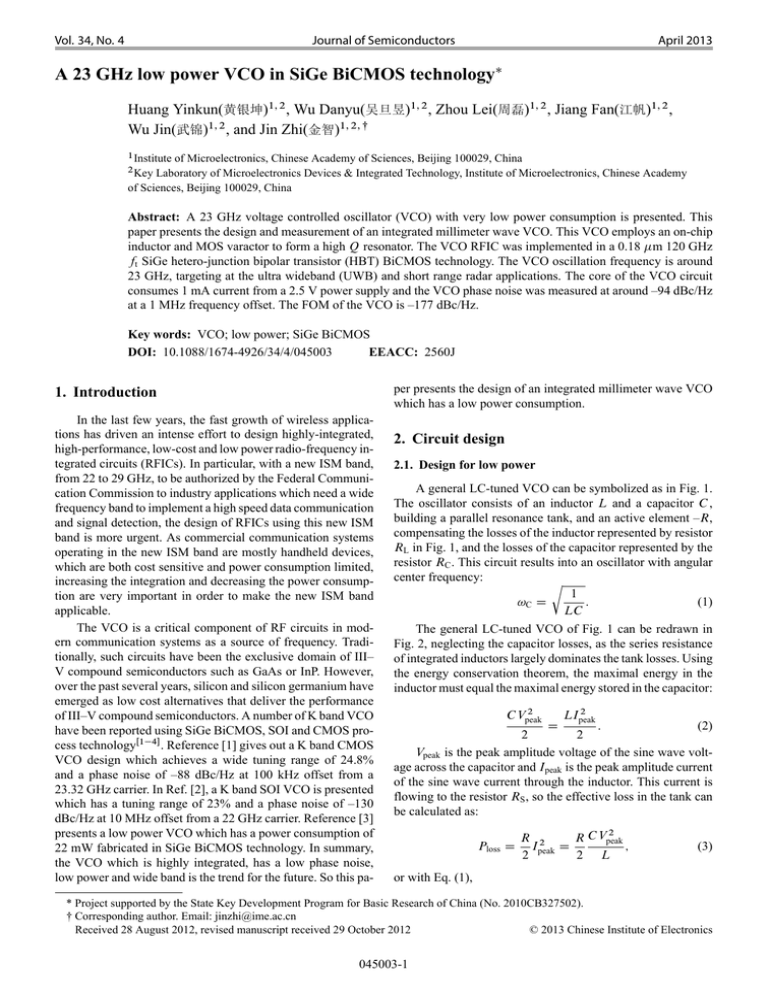
Vol. 34, No. 4
Journal of Semiconductors
April 2013
A 23 GHz low power VCO in SiGe BiCMOS technology
Huang Yinkun(黄银坤)1; 2 , Wu Danyu(吴旦昱)1; 2 , Zhou Lei(周磊)1; 2 , Jiang Fan(江帆)1; 2 ,
Wu Jin(武锦)1; 2 , and Jin Zhi(金智)1; 2;
1 Institute
of Microelectronics, Chinese Academy of Sciences, Beijing 100029, China
Laboratory of Microelectronics Devices & Integrated Technology, Institute of Microelectronics, Chinese Academy
of Sciences, Beijing 100029, China
2 Key
Abstract: A 23 GHz voltage controlled oscillator (VCO) with very low power consumption is presented. This
paper presents the design and measurement of an integrated millimeter wave VCO. This VCO employs an on-chip
inductor and MOS varactor to form a high Q resonator. The VCO RFIC was implemented in a 0.18 m 120 GHz
ft SiGe hetero-junction bipolar transistor (HBT) BiCMOS technology. The VCO oscillation frequency is around
23 GHz, targeting at the ultra wideband (UWB) and short range radar applications. The core of the VCO circuit
consumes 1 mA current from a 2.5 V power supply and the VCO phase noise was measured at around –94 dBc/Hz
at a 1 MHz frequency offset. The FOM of the VCO is –177 dBc/Hz.
Key words: VCO; low power; SiGe BiCMOS
DOI: 10.1088/1674-4926/34/4/045003
EEACC: 2560J
per presents the design of an integrated millimeter wave VCO
which has a low power consumption.
1. Introduction
In the last few years, the fast growth of wireless applications has driven an intense effort to design highly-integrated,
high-performance, low-cost and low power radio-frequency integrated circuits (RFICs). In particular, with a new ISM band,
from 22 to 29 GHz, to be authorized by the Federal Communication Commission to industry applications which need a wide
frequency band to implement a high speed data communication
and signal detection, the design of RFICs using this new ISM
band is more urgent. As commercial communication systems
operating in the new ISM band are mostly handheld devices,
which are both cost sensitive and power consumption limited,
increasing the integration and decreasing the power consumption are very important in order to make the new ISM band
applicable.
The VCO is a critical component of RF circuits in modern communication systems as a source of frequency. Traditionally, such circuits have been the exclusive domain of III–
V compound semiconductors such as GaAs or InP. However,
over the past several years, silicon and silicon germanium have
emerged as low cost alternatives that deliver the performance
of III–V compound semiconductors. A number of K band VCO
have been reported using SiGe BiCMOS, SOI and CMOS process technologyŒ1 4 . Reference [1] gives out a K band CMOS
VCO design which achieves a wide tuning range of 24.8%
and a phase noise of –88 dBc/Hz at 100 kHz offset from a
23.32 GHz carrier. In Ref. [2], a K band SOI VCO is presented
which has a tuning range of 23% and a phase noise of –130
dBc/Hz at 10 MHz offset from a 22 GHz carrier. Reference [3]
presents a low power VCO which has a power consumption of
22 mW fabricated in SiGe BiCMOS technology. In summary,
the VCO which is highly integrated, has a low phase noise,
low power and wide band is the trend for the future. So this pa-
2. Circuit design
2.1. Design for low power
A general LC-tuned VCO can be symbolized as in Fig. 1.
The oscillator consists of an inductor L and a capacitor C ,
building a parallel resonance tank, and an active element –R,
compensating the losses of the inductor represented by resistor
RL in Fig. 1, and the losses of the capacitor represented by the
resistor RC . This circuit results into an oscillator with angular
center frequency:
r
1
!C D
:
(1)
LC
The general LC-tuned VCO of Fig. 1 can be redrawn in
Fig. 2, neglecting the capacitor losses, as the series resistance
of integrated inductors largely dominates the tank losses. Using
the energy conservation theorem, the maximal energy in the
inductor must equal the maximal energy stored in the capacitor:
2
C Vpeak
D
2
LIpeak
:
(2)
2
2
Vpeak is the peak amplitude voltage of the sine wave voltage across the capacitor and Ipeak is the peak amplitude current
of the sine wave current through the inductor. This current is
flowing to the resistor RS , so the effective loss in the tank can
be calculated as:
2
Ploss D
R C Vpeak
R 2
Ipeak D
;
2
2 L
(3)
or with Eq. (1),
* Project supported by the State Key Development Program for Basic Research of China (No. 2010CB327502).
† Corresponding author. Email: jinzhi@ime.ac.cn
Received 28 August 2012, revised manuscript received 29 October 2012
© 2013 Chinese Institute of Electronics
045003-1
J. Semicond. 2013, 34(4)
Huang Yinkun et al.
Fig. 1. Basic LC-VCO.
Fig. 3. Schematic of VCO.
Fig. 2. Basic LC-resonator tank.
Ploss D
R
R
2
C2 !C2 Vpeak
D
V2 :
2
2L2 !C2 peak
(4)
This loss must be compensated by the active part of the
VCO to sustain the oscillation. Ploss in the above equations is
the fundamental minimum for the power consumption of a LCVCO. The equations lead to some significant conclusions for
the design of low power consumption of any LC-VCO:
(1) Power consumption decreases linearly with the series
resistances in the resonance;
(2) Power consumption decreases quadratically when the
tank inductance is increased so that the oscillator frequency is
assumed to be a constant;
(3) Power consumption decreases quadratically when the
tank capacitance is decreased so that the oscillator frequency
is assumed fixed;
(4) Power consumption decreases quadratically with the
oscillation frequency when the tank inductance is a constant.
Power consumption increases quadratically with the oscillation
frequency when the tank capacitance is a constant.
2.2. Design for low phase noise
From Leeson’s empirical phase noise theoriesŒ5 , the phase
noise of a resonator-based VCO can be expressed as:
2F T
L.!C ; f / D 10 lg
Psig
"
1C
!1=f 3
;
1C
j!j
!C
2QL !
Table 1. Low-power low phase noise design strategy.
Parameter
Low power
Low phase noise
L
Maximize
Maximize
C
Minimize
Minimize
RS
Minimize
Minimize
Amplitude
Minimize
Maximize
2 #
"
F T
L.!C ; f / D 10 lg
2
2Psig
Rs
L!
2 #
"
#
F TRs
1
D 10 lg
:
2
LC! 2
Vsig
(6)
Equation (6) shows that the way to reduce phase noise, is
2
to increase Vpeak
and use a LC-tank with a higher Q or higher
L=Rs ratio.
2.3. Design for low power low phase noise VCO
As already stated in Sections 2.1 and 2.2, the critical factor
for the design of low power low phase noise VCO is to provide
a high Q resonator. From Eq. (6), for the lowest phase noise
at minimal power consumption Q D !c L=Rs must be maximized. So the resulting guidelines for low power low phase
noise VCO are summarized in Table 1, !c is assumed fixed.
3. Implementation and measurement results
(5)
where QL is the loaded quality factor of the tank, ! D 2f
is the angular frequency offset, and F is called the device
3
noise excess factor or simply the noise factor. !1=f
describes
the flicker noise corner frequency and is not equal to the device flick noise corner frequency. Neglecting the flicker-noise
portion and with Qtank D !c L=Rs , !c ! and Psig D
2
2
2
Vsig
/(2Rp / D Vsig
/(2Qtank
Rs / Leeson’s equation simplifies to:
In order that the VCO could be used in the new ISM band,
the output frequency is set to 24 GHz and the phase noise
at 1 MHz offset is 95 dBc/Hz. Figure 3 shows a simplified
schematic of the complete VCO circuit implementation. The
VCO is mainly composed of an active core formed by two
cross-coupled transistors Q1 and Q2, a resonance tank consisting of a pair of single-end inductors and MOS varactors, and a
tail current source. Directly coupled is applied in this design in
order to ensure the reliable operation under a breakdown voltage between the collector and emitter (BVCEO /.
045003-2
J. Semicond. 2013, 34(4)
Parameter
Technology
RF frequency (GHz)
Phase noise (dBc/Hz)
Die size (core) (mm2 /
Tuning range
Power dissipation (mW)
FOM (dBc/Hz)
Huang Yinkun et al.
Table 2. Comparison of VCO performance.
Ref. [7]
Ref. [8]
Ref. [9]
0.13 m SiGe BiCMOS
0.18 m CMOS
0.13 m CMOS
25
24.27
23
82:5 @ 500 kHz
100 @ 1 MHz
100 @ 1 MHz
0.115
0.42
0.32
10%
2.2%
2%
22
7.8
10
162
179
181
This work
0.18 m SiGe BiCMOS
22.5
94 @ 1 MHz
0.12
5%
2.5
177
Table 3. Simulated versus measured.
Parameter
Simulated
Measured
Output frequency (GHz)
23.7–24.9
22.5–23.7
Phase noise @ 1 MHz (dBc/Hz)
95
94
Power consumption (mW)
2.25
2.5
Fig. 4. Photo of the oscillator.
According to the analysis of Section 2, the tank design
goals can be recapitulated as (1) maximize L=C the ratio of
inductance to capacitance, and (2) maximize L=R, the ratio
of inductance to resistance. The minimal channel length and
multi-finger are preferred for MOS-varactor to provide high
quality factors. An octagonal inductor and minimal line space
are applied to achieve high quality values. The optimized width
and inductance of the inductor are 15 m and 350 pH respectively. The total capacitance of the resonator is 120 fF which
consists of the parasitic capacitance of the Q1, Q2 and the following buffer. The amplitude of the oscillation core is 800 mV
(Vp p /.
The layout is also a key part of the K band VCO. The most
critical nodes are the positive and negative oscillation nodes
which have to be carefully designed to prevent capacitive and
resistive parasitic effects. The connections of these nodes are
designed using the top metal layer and a sufficient number of
vias to reduce the parasitic capacitor and resistance.
The proposed LC VCO shown in Fig. 3 is fabricated in
HHNEC 0.18 m SiGe BiCMOS technology. The chip micrograph is shown in Fig. 4 and the active area is about 750
600 m2 . The measured output frequency of this design
is 23 GHz. The oscillator core only consumes 1 mA current
from a 2.5 V supply. The measured phase noise is around
94 dBc/Hz at 1 MHz offset from a 22.5 GHz carrier frequency
as shown in Fig. 5. The simulated and measured results are
summarized in Table 3.
A figure-of-merit (FOM) is employed to evaluate the three
performance parameters of the VCO: frequency, phase noise
and power consumptionŒ6 , which are
Fig. 5. Measured output spectrum and phase noise.
FOM D 10 lg
! 0 2
1
;
! Lf!gP
(7)
where L {!} is the total single-sideband phase noise spectral
density at an offset frequency ! from the carrier frequency
!0 . P valued in mW is the power dissipated by the oscillator
core. The higher value of the FOM implies that the oscillator
has achieved a better performance. Performance is summarized
in Table 2.
4. Conclusion
In this paper a ultra low power VCO is designed in HHNEC 0.18 m SiGe BiCMOS technology. The VCO core consumes a 1 mA current from 2.5 V supply and achieves a phase
noise of 94 dBc/Hz at 1 MHz offset from a carrier frequency
of 22.5 GHz. The value of FOM for this design achieves
177 dBc/Hz.
Acknowledgment
The authors genuinely appreciate the help of all the members of the IMECAS compound semiconductor device department and acknowledge HHNEC for providing the opportunity
for chip fabrication.
045003-3
J. Semicond. 2013, 34(4)
Huang Yinkun et al.
References
[1] Osorio J, Vaucher C S, Huff B, et al. A 21.7-to-27.8 GHz 2.6degrees-RMS 40 mW frequency systhesizer in 45 nm CMOS for
mm-wave communication applications. IEEE ISSCC, 2011: 278
[2] Sadhu B, Ferriss M A, Plouchart J O, et al. A 21.8–27.5 GHz PLL
in 32 nm SOI using Gm linearization to achieve –130 dBc/Hz
phase noise at 10 MHz offset from a 22 GHz carrier. IEEE Radio
Frequency Integrated Circuits Symposium, 2012: 75
[3] Nagarajan M, Ma K, Seng Y K, et al. A low power wide tuning
range low phase noise VCO using coupled LC tanks. Semiconductor Conference Dresden (SCD), 2011: 1
[4] Osmany S A, Herzel F, Scheytt J C, et al. Integrated 22 GHz lowphase-noise VCO with digital tuning in SiGe BiCMOS technol-
ogy. Electron Lett, 2009, 45(1): 39
[5] Leeson D B. A simple model of feedback oscillator noises spectrum. Proc IEEE, 1966, 54: 329
[6] Kinget P. Integrated GHz voltage controlled oscillators. Norwell,
MA: Kluwer Academic Publishers, 1999
[7] Kakani V, Jin Y, Dai F F. A 25 GHz wide-tuning VCO RFIC implemented in 0.13 m SiGe BiCMOS technology. IEEE Bipolar/BiCMOS Circuits and Technology Meeting (BCTM), 2010
[8] Yang J, Kim C, Kim D, et al. Design of a 24-GHz CMOS VCO
with an asymmetric-width transformer. IEEE Trans Circuit Syst
II, 2010, 57(3): 173
[9] Hsieh C, Kao K, Ronald Tseng J, et al. A K-band CMOS low
power modified colpitts VCO using transformer feedback. IEEE
MTT-S Int Microwave Symp Dig, 2009: 1293
045003-4

